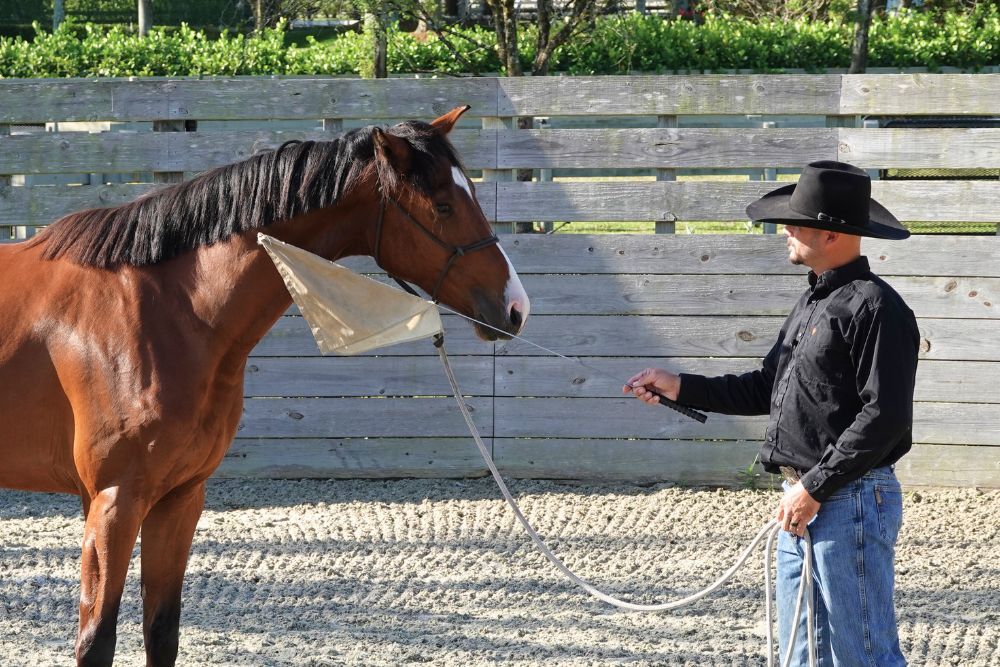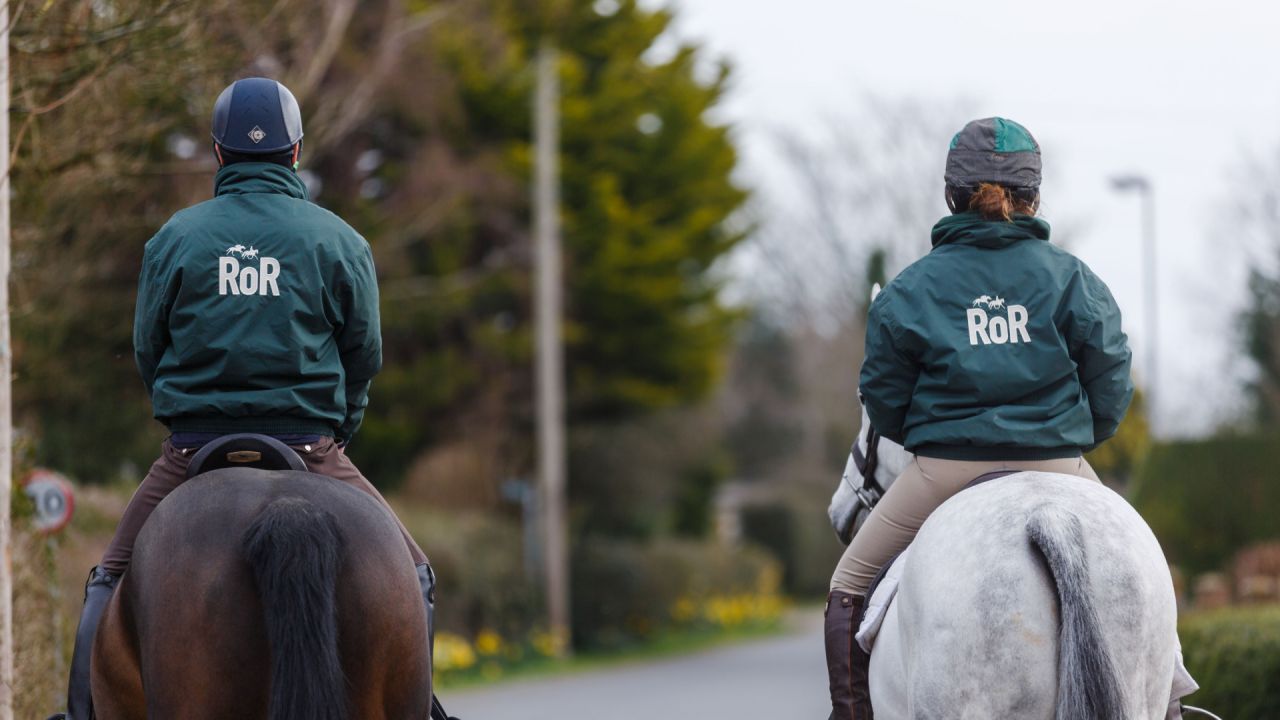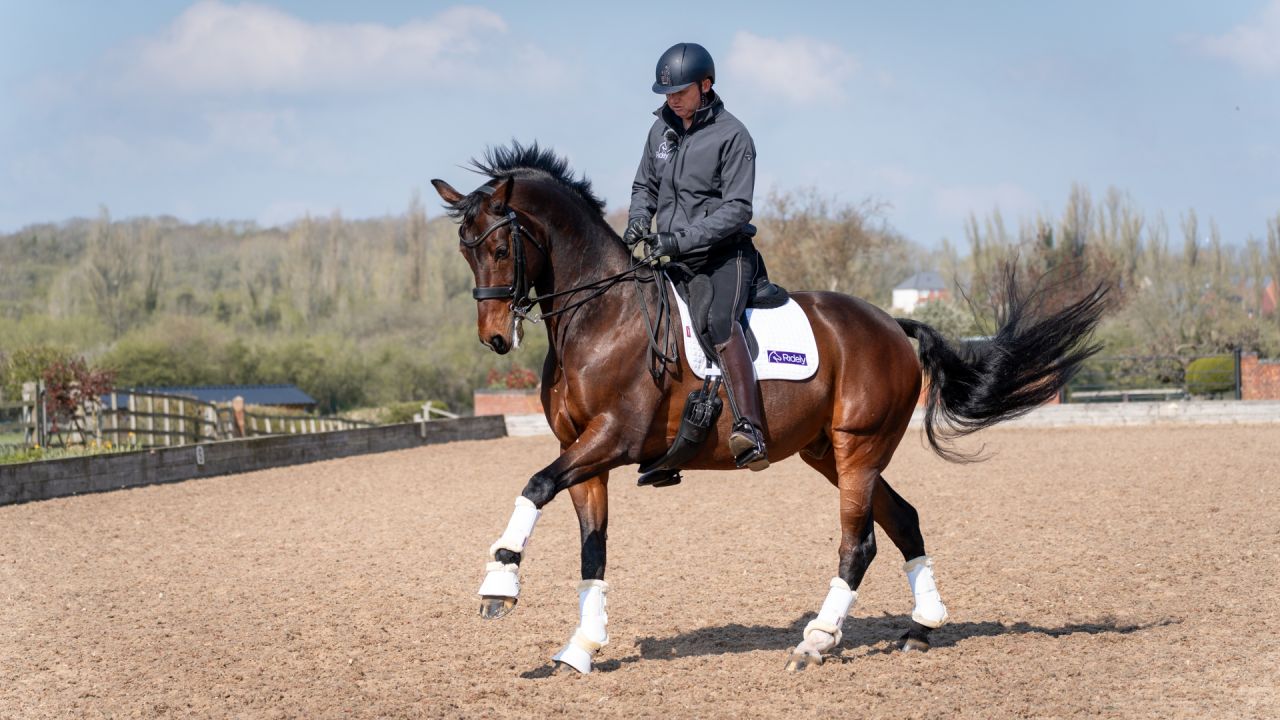Groundwork Exercises to Calm Down A Spooky Horse: Flag Work

Do you have a spooky horse or a young horse that you want to desensitise? Flag work is a great technique to help with this.
In this article, Horsemanship Expert Dana Glass will show you how you can use the flag to understand your horse’s reactions and also to help them feel more confident with different pressures.
The Basics of Flag Work
It is important to note that the flag is just an extension of your arm. It is not a weapon or something that you need to chase the horse with. Using the flag helps the horse learn to think for themselves.
Sometimes as a rider, you might make a mistake and the horse fills in the gaps for you. For example in a dressage test you might ride the first 13 one time changes and then the horse does the last two as you stopped counting. By encouraging your horse to think for themselves early on, you will be able to rely on them a little bit as you continue to develop your bond.
Introducing the Flag:
- When introducing the flag to your horse, make sure you bring it in from above and slightly to the side. The horse has blindspots directly in front of them so avoid bringing it in from the ground.
- Your horse might become scared and run from the flag. Keep moving the flag while he moves his feet and when he does settle and stop, using the flag to pet on the horse’s back to show him it’s not scary! You might want to shorten the lead and be closer to him so he can’t run as far.
- You might need to do this a few times until your horse settles with having the flag around. This might take minutes or weeks depending on how spooky your horse is!
- Once your horse is a little more settled, you can use the flag to touch different parts of his body. This is a good tool for touching horses that kick out and getting them used to having their back legs touched. Make sure you’re stood at the front and side of the horse when doing so.
Adding movement:
- You can also start to add movement in with the flag. If the horse runs and gets frightened, keep shaking until he settles and then pet on him.
- The next step after this is to use the flag to mimic your leg aid. Ask the horse to move off in walk and then tap him where your leg would be to ask for trot.
- Try adding transitions on a circle and leg yielding in and out with the flag here.
- Once your horse becomes really responsive to this. Try asking for these transitions just with your body and by taking your hand higher out to the side. If the horse doesn’t go, you can show him the flag. In Dana’s video, his horse reacts and makes a transition into trot just from seeing the flag. Yours might take more time to become this responsive, if your horse still doesn’t go then bring the flag back to where the leg aid was.
The end goal is to be able to have your horse so confident and relaxed with the flag that you can let them stand loose and shake the flag all around them without them moving or even reacting. This will take time though! Revisit any of the steps you need. If you go in with the flag and overface the horse, don’t worry. Just take it back a step and slowly build up, or work on the same thing repetitively so your horse gets used to it.
Introducing Lateral Movement with the Flag
Once your horse is more comfortable with the flag, you can begin to use it to introduce lateral movement. Dana shows you a few things you can do to encourage your horse’s attention to stay with you rather than his surroundings. Make sure you go back to part one if you need to work with the flag a little more.
- See if you can leg yield your horse and get them to cross their hindlegs.
- Use the techniques learnt earlier in the program to set your horse off in one direction and use the flag and your energy to ask the hindlegs to engage by crossing sideways.
- Think about which foot needs to move and where it needs to be in order to achieve the steps and crossing desired.
- For example, in the video Dana shows you how he asks the horse to reach with his front left foot when stepping out the left. We want to achieve reach in all steps as this is a good foundation for riding dressage movements in the future.
- If you’re successful in getting a few crossing steps behind, try and get your horse to change directions after crossing:
- Start by asking the hindlegs to cross and when they do, focus on the outside foot planting.
- Once the outside foot has planted, you can ask the horse to use that to shift his weight to the other direction and take a step the other way.
- Dana rolls the horse’s hips to achieve this.
- Make sure you get the crossing before changing direction. You might need to go round the circle a few times before you get good crossing steps!
- Dana uses his body to encourage energy by placing his hand out to the direction he is asking the horse to go and then he carries the flag behind him.
Acknowledging the Horse’s Blind Spots
Your horse has two main blind spots: right in front of them, and right behind them. In this part, Dana shows you how to introduce putting the flag into these blind spots. It is very important that you do not attempt this until your horse is very accepting of the flag and is very relaxed around it. If not, go back to parts one and two.
Your horse might react and run when the flag is in front or behind him. If the flag is in the blindspot below the horse (or at the front on the ground) it can cause the horse to rear and strike so be very careful!
Make sure you start with small things first. Don’t use a bag on a windy day on the end of a stick! Start with the handle end in the blind spot and don’t put too much into the blind spots that could overwhelm the horse. Make sure they can comprehend what you are putting there.
Blind Spot Exercise 1:
- Step out to the side and get the horse’s feet moving around you.
- Next, start moving the flag in and out of the blind spot in front of the horse’s legs.
- When he gets stuck and won’t continue the forward movement, remove the flag, send him forward again, then put the flag back in and out of the blind spot.
- The movement of the legs slightly sideways should help to prevent a rear, but still take caution.
Blind Spot Exercise 2:
- Stand in front of your horse facing him.
- Make the line nice and long and create a big gap between you and your horse.
- Begin to walk backwards and ask your horse to follow you.
- As the horse follows you, you can gently swipe the flag across the blind spot in front of him (a bit like you’re using a metal detector left and right).
- When the horse is happy with this and walking nicely ignoring the flag, turn around and walk away with him to take all of the pressure away.
- When your horse gets good at this you can begin to touch his legs with the flag and see how he reacts.
If you want to see all this in action and continue your groundwork journey towards better horsemanship, join Dana’s Training Program in the Ridely app. This is from the second session out of four in total which focuses on the importance of good groundwork.

- Train with 11+ Olympians from home.
- Learn and make the most of your equestrian life.

Learn from Carl Hester in Ridely!
Exclusive training videos with top trainers and riders like Carl Hester are available in the Ridely library. Don’t miss out!


